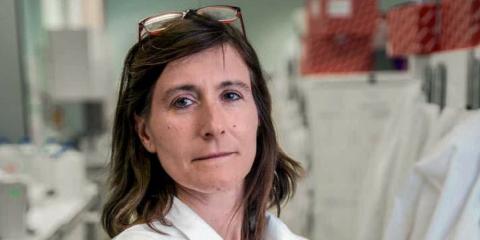
Cécile Martinat: How to debunk the use of stem cells in research
Cécile Martinat is Director of the Institute of Stem Cells for the Treatment and Study of Monogenic Diseases (I-Stem - Université Paris-Saclay, Inserm, Université d'Évry). She carries out her research activities at the same time as her commitment to the organisation and defence of the human stem cell scientific community in France.
Cécile Martinat admits that she became a researcher "by opportunity" and has never made a career plan. "After my thesis in virology at the Pasteur Institute, I chose to go to Columbia University for a post-doc, mainly because it was in New York". There she worked on human stem cells, and felt fascinated by the "Harry Potter" aspect of this type of research, which was authorised in 1998 in the United States. Since the bioethics law made it possible in France in 2005, Marc Pechanski invited her to join the team involved in the creation of I-Stem.
From its creation in partnership with the French Muscular Dystrophy Association (AFM Téléthon), I-Stem combines state-of-the-art technological equipment with scientific innovation. The institute uses human pluripotent stem cells to better understand the development of certain genetic diseases and to identify therapeutic leads. There are two research lines in the teams. The first line, led by Christelle Monville, focuses on innovative cell therapy. Cécile Martinat leads the second line, dedicated to pathological modelling. The aim is to use stem cells of embryonic origin or those induced to pluripotency by genetic conversion of patients' somatic cells in order to understand the presence of a mutation. "This is a mechanistic research. We study how the mutation affects the functionality of a well-defined cell type, and we identify therapeutic leads by focusing on pharmacological approaches."
The researcher is particularly interested in neuromuscular diseases. "I'm trying to understand how certain mutations disrupt the neuromuscular system and how motor neurons communicate with their muscle targets. We use complex models of pluripotent stem cells converted to motor neurons."
A smart society that stands up for itself
"Since 2005, all our programmes undergo authorisation from the Biomedicine Agency, which comes under the Ministry of Health," explains Cécile Martinat. But since 2013, such authorisations are systematically contested by extremist foundations. 50 of the 90 authorisations are currently pending before the courts". For the researcher, this situation is both unfair and ridiculous. "These attacks, against which neither the researchers nor the Agency are prepared to respond, threaten years of research and development."
In 2017, together with several French researchers, she created the French Society for Stem Cell Research (FSSCR), which she chaired since then. "This society is intended to better federate the French stem cell scientific community. At the same time, it also allows us to take part in the public debate in the context of the revision of the bioethics law," says Cécile Martinat, who has been heard by the National Consultative Ethics Committee (CCNE) and the National Assembly. After Paris in 2017 and Nantes in 2018, the third annual congress of the Savant Society took place in Lyon in November 2019.
A wide communication
With media reporting on human stem cell injections in patients in a number of countries, the researcher is keen to share among a wide audience on "what is feasible or not". This begins with her commitment to middle and high school students as part of Operation 1000 Researchers in Schools.
I try to make them aware of genetic diseases and research careers," she says. I tell them that being a girl with a rural background does not mean you cannot study in Paris. I describe my daily life as a researcher, far from the image of the lone French scientist Professor Tournesol. Communicating is a major part of our profession."

